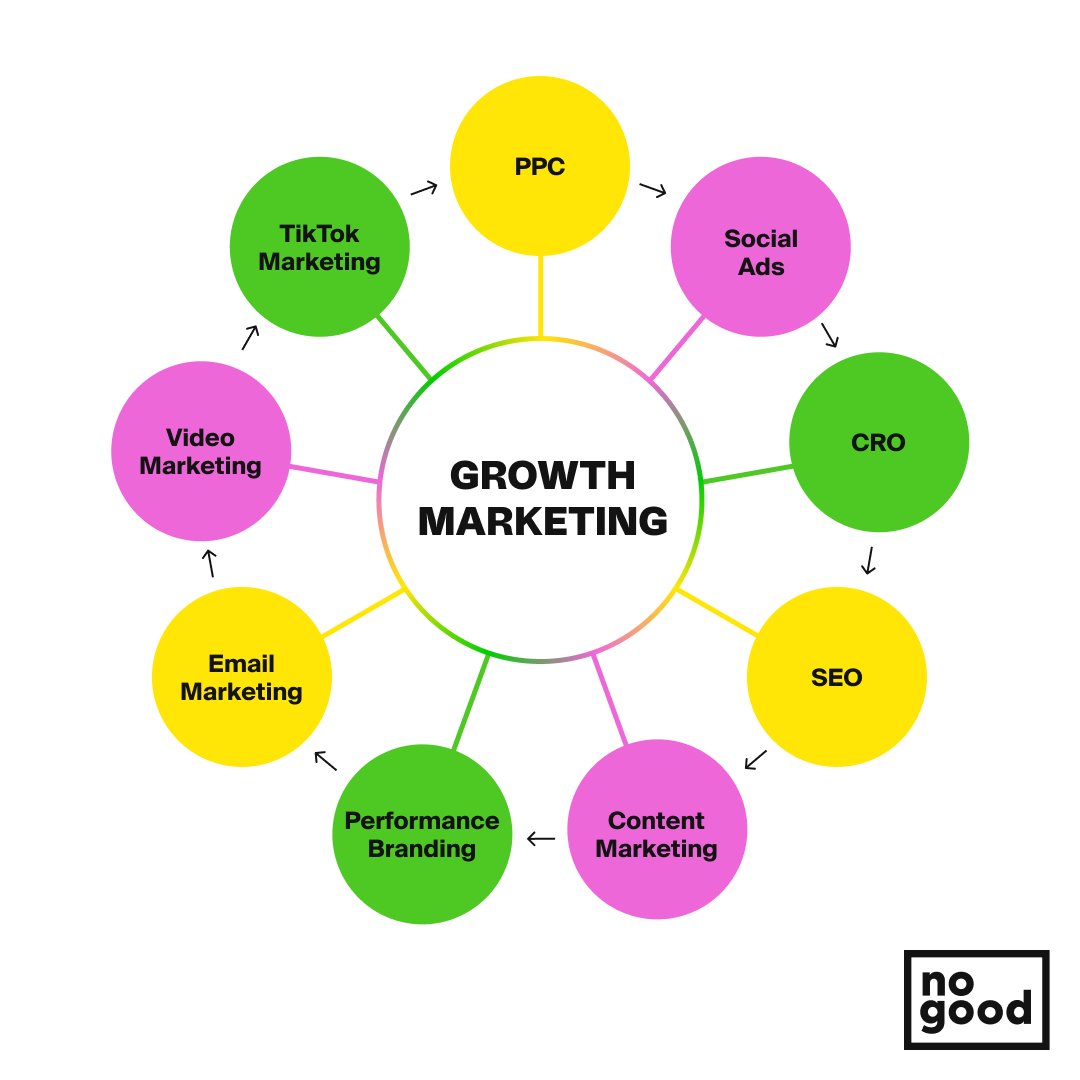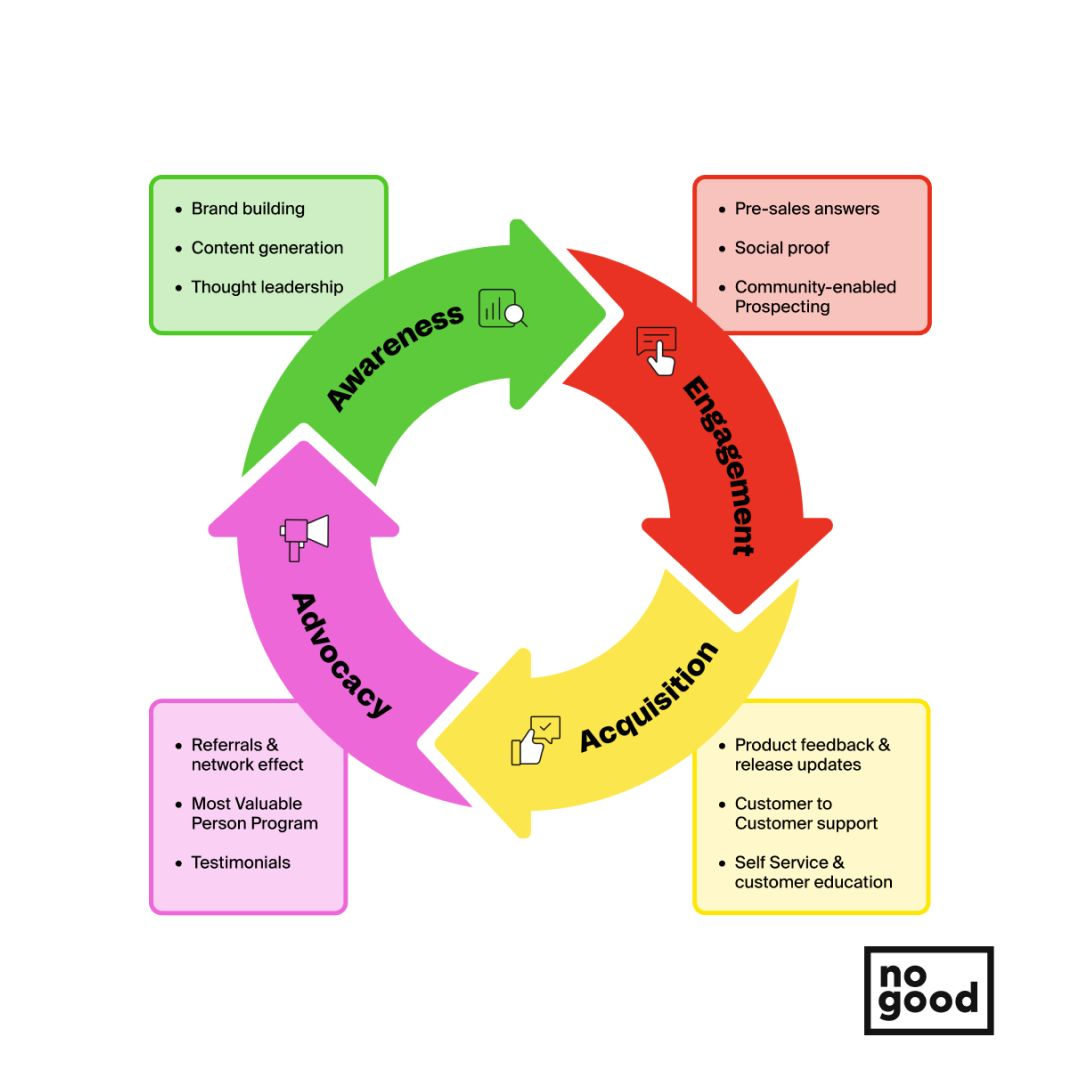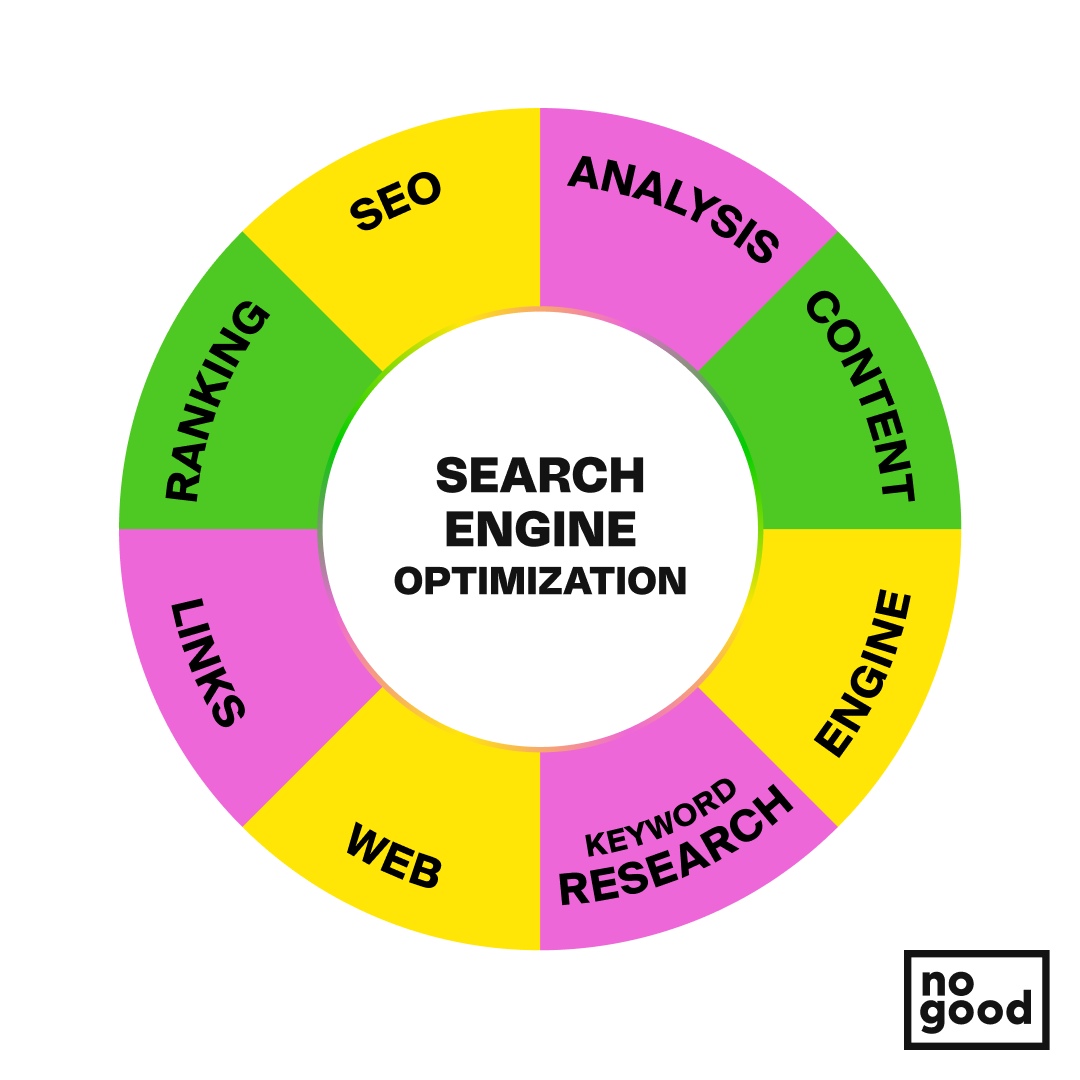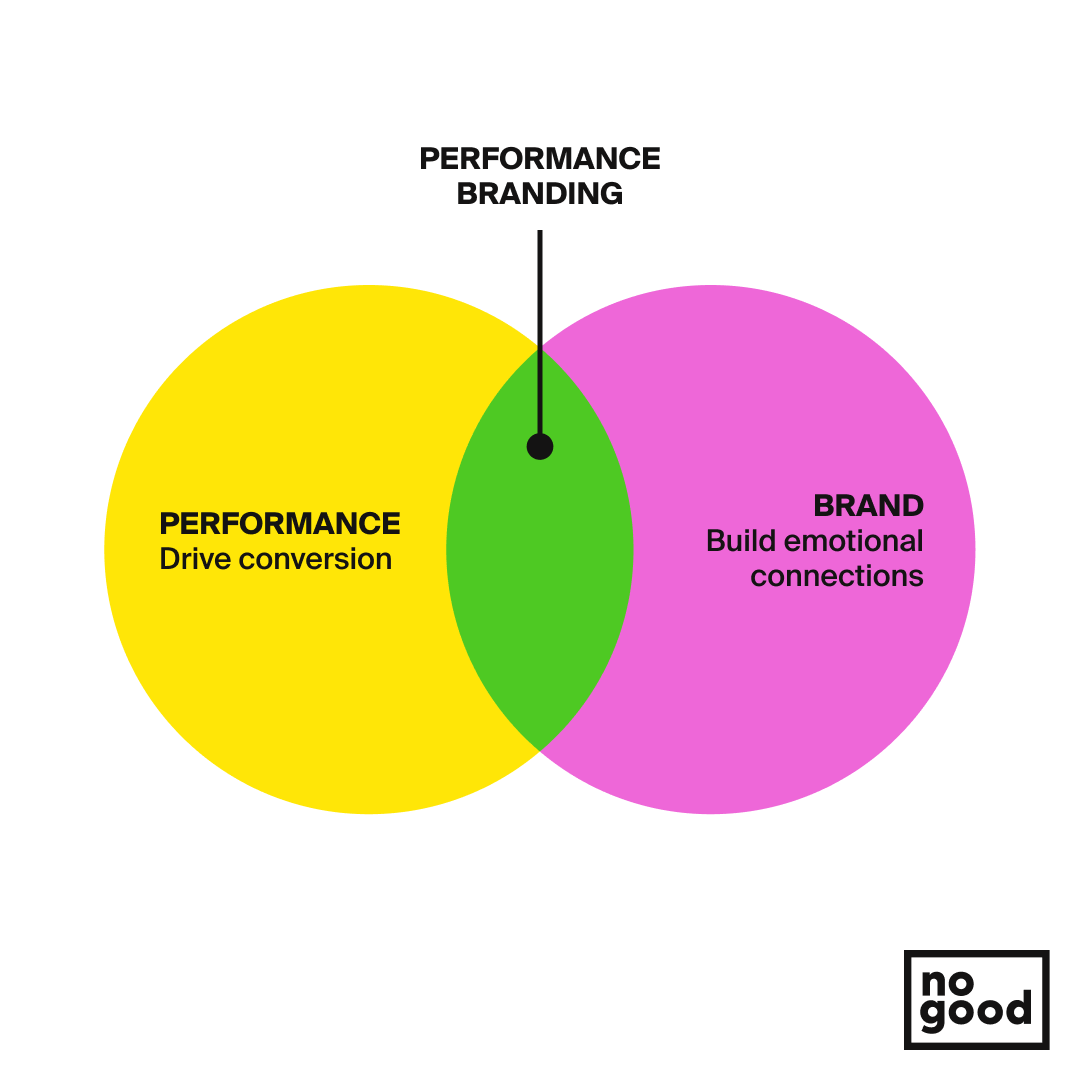Updated November 2024
What is Growth Marketing?
Growth marketing is a strategic, data-driven approach to growing a brand by building long-term customer relationships throughout its journey—from awareness to advocacy. Growth marketers use a holistic toolkit to attract, engage, retain, and convert audiences into loyal advocates. This approach goes beyond conventional marketing, optimizing the entire funnel to maximize customer acquisition and retention.
How do Growth Marketers Work?
Growth marketers constantly test and refine strategies across all touchpoints in the customer journey. Analyzing data at each stage, they adapt and implement strategies that remove bottlenecks and drive sustained growth. This cross-functional approach enables a shift from simply acquiring customers to building enduring customer relationships, optimizing down-funnel experiences based on insights from campaign data.
For example, a growth marketer might launch an SEO-driven content campaign to build awareness, guide users to a quiz for personalized engagement, and incorporate UGC for social proof. This would be followed by a post-purchase email flow to foster advocacy. The marketer would monitor each stage, adjust as needed, and continually optimize for the best results.
Quick Quiz: What Would a Growth Marketer Do?
If a marketer finds high conversions from blog traffic but low post-purchase feedback, which tactics might they consider?
- Optimize the blog for SEO
- Enhance the quiz for deeper insights
- Strengthen the UGC strategy
- Improve the email flow for feedback
Answer: All of the above. Growth marketers use data and optimization at every stage.
If you answered all of the above, you’re correct! While a growth marketer would implement strategies like A/B testing CTAs in the email flow, changing button colors, or trying new preview text to find better outcomes for their email flow, they would simultaneously be optimizing for the rest of the customer journey to continue to drive results once they cleared the bottleneck within their email flow.
This is the essence of growth marketing, and these are the tools that are used:
- A/B testing
- Content marketing
- Email marketing
- SEO/SEM/PPC
- Social Ads
- CRO
- SEO
- Performance Branding
- Video Marketing
- SMS Marketing

Traditional Marketing vs. Growth Marketing
Growth marketing departs from traditional marketing by emphasizing continuous testing, data-driven decisions, and personalized customer interactions. Here’s how it breaks down:
| Traditional Marketing | Growth Marketing |
| Focus on customer acquisition | Focus on acquisition and retention |
| Short-term conversion focus | Long-term engagement and loyalty |
| Intuition-based decisions | Data-driven optimization |
| Linear sales funnel | Iterative growth loops |

Growth loops are a core aspect of growth marketing. They create sustainable value by continuously attracting new users, engaging existing ones, and nurturing them to become advocates. Unlike a one-way sales funnel, growth loops harness current customers to drive additional growth.
As a growth marketing professional, your mission goes beyond simply converting leads into customers; it’s about guiding your audience through every stage of the growth loop and turning them into brand advocates. Growth loops add value in multiple dimensions — from attracting new users and retaining existing ones to building more profound engagement, enhancing brand awareness, and fostering advocacy. Retaining a current customer offers a 60–70% chance of conversion, far surpassing the 5–20% chance of new customer acquisitions. Notably, new customers can be up to seven times more costly to acquire than retaining existing ones, highlighting the importance of focusing on customer retention to maximize lifetime value (LTV).
But what does a customer-centric focus indeed mean? More than ever, businesses of all sizes are re-evaluating their marketing strategies to meet the demand for authenticity, transparency, and quality. Putting customers first requires aligning with their pace, and growth marketing empowers brands to gain critical insights through testing. These insights reveal your target audience’s trends, preferences, and values, enabling you to build lasting relationships through campaigns that are laser-focused on the individual.
In growth marketing, every campaign centers around a “north star” goal, carefully chosen to test, learn, and optimize. This north star doesn’t have to be revenue-based; it can be tied to crucial KPIs that reveal potential product impact and long-term business outcomes.
While growth marketing traditionally follows the scientific method — problem-solving through controlled tests, data-driven insights, and continuous improvement — the modern approach has shifted to what is often called the “racecar” framework. As the name suggests, this framework emphasizes a sustainable yet accelerated growth model achieved through a carefully designed infrastructure that enables long-term growth.
The “Racecar” framework helps to conceptualize the mechanics of growth marketing:
- The Engine: Your growth engine consists of the core strategies that drive growth, often via growth loops. These mechanisms require regular monitoring and adjustments to keep the engine running smoothly.
- Turbo Boost: These are short-term tactics—such as viral campaigns or influencer partnerships—that temporarily accelerate growth. While impactful, turbo boosts are supplementary to a consistent strategy.
- Lubricants: Lubricants refer to optimization efforts—such as A/B testing and CRO—that smooth out bottlenecks across the customer journey.
- Fuel: Fuel includes the resources that power the engine, from paid media budgets and content to community engagement. Without fuel, even the best engine can’t run.
Growth Marketing Tactics
A successful growth strategy leverages diverse tactics that span the customer journey. Here’s a breakdown:
1. PPC and SEM Marketing
Pay-per-click (PPC) and search engine marketing (SEM) campaigns are essential for customer acquisition. PPC ads target keywords that align with customer intent for conversions, lead generation, or brand awareness. PPC is all about relevance. Users search for specific products, services, and information at any time. Advertisers can present a tailored ad when that search occurs. If a user searches for “red lipstick,” an advertiser can show an ad about “red lipstick.”
2. Community-Led Growth
As brands focus more on building longstanding relationships with users, community-led growth is becoming a primary focus of many growth marketing strategies. By creating authentic connections through community engagement, brands foster loyalty and leverage creators as ambassadors. Community-led growth encourages organic brand advocacy and facilitates customer-driven content.
3. Product-Led Growth
Brands are discovering now more than ever that growth can be built directly into their products to encourage user interaction, sharing, and advocacy as an extension of the product itself. This can happen with features that promote sharing, onboarding, and referrals built into the product. By focusing on user experience, product-led growth aims to drive retention and referrals naturally.
4. Paid Social Media Advertising
What is the best way to spend money on social media ads? Although you may think the solution lies in knowing which social network has the most extensive user base, there is only one perfect answer. The truth is that it all depends on the circumstances. When choosing, consider where to find your target audience on social media, what type of campaign you want to run, and how you can best use your advertising budget. Below is a brief overview of the most common forms of social media advertising options.
In 2024, each social media platform offers unique advertising capabilities, allowing brands to tailor their strategies for optimal engagement and conversions. Here’s an updated breakdown:

1. Meta
Meta remains the largest social networking platform globally and is well-known for its reliable and sophisticated advertising options. With Meta for Business, brands can leverage advanced segmentation features, from demographic and interest-based targeting to Lookalike Audiences, which maximize reach among similar user groups. Its format flexibility across feeds, stories, and short-form video ensures brands can effectively deliver visually engaging content tailored to their audience.
2. Instagram
Instagram’s focus on high-quality visuals and short-form video content makes it a top choice for reaching younger audiences, especially Millennials and Gen Z. To maximize Instagram’s potential, look for examples of effective Instagram ads within your industry to inspire your own. Focus on optimizing the quality of photos and videos, using Instagram’s ad formats—like Stories, Reels, and Carousel ads—to align with platform trends and enhance audience engagement.
2. Twitter (X)
Twitter, now branded as “X,” enables advertisers to create campaigns tailored to specific goals, such as conversions, leads, and app installs. Integrating artificial intelligence has become a significant advantage for Twitter advertising, as AI-powered algorithms allow brands to enhance ad personalization and optimize campaigns in real time for better results. Twitter remains famous for conversational and time-sensitive content, which helps brands stay relevant and responsive.
3. TikTok
TikTok marketing encompasses several strategies, from User-Generated Content (UGC) campaigns and influencer partnerships to paid advertising. Its unique algorithm prioritizes engaging, authentic content, so ads that blend seamlessly with organic content tend to perform best. TikTok’s focus on viral, short-form video content encourages brands to develop creative, catchy ads that tap into popular trends and challenges, making it especially effective for reaching Gen Z and Millennial audiences.
4. Pinterest
Pinterest is a visually-driven platform ideal for home decor, fashion, beauty, and DIY brands. Pinterest marketing involves creating eye-catching visuals that stand out in users’ feeds and inspire action. The platform’s Visual Search and Shoppable Pins have expanded conversion opportunities. At the same time, Pinterest’s audience, increasingly Gen Z and Millennials, seeks creative ideas and product inspiration, making it a valuable part of any visually-focused social media strategy.
5. Conversion Rate Optimization (CRO)
The goal of CRO marketing (also known as conversion rate optimization) is to increase the number of website visitors who convert. These are incentives for consumers to perform the desired activity (e.g., download a video, sign up for a subscription, place an order, etc.). Any company that wants to achieve tangible results from its marketing and sales efforts needs a plan for CRO. It not only promotes the company but also encourages people to take action. These actions help to increase the company’s popularity and revenue.
For a successful CRO strategy, the website design must first inspire confidence in visitors. It should be easy to navigate and use to ensure your efforts to capture paid or organic traffic aren’t lost once the user reaches your site. The last step is perhaps the most challenging. All those visitors are useless to your business if they are not driven to take action. Therefore, your website needs to be able to convert some of those visitors into leads, subscribers, and customers.
6. Search Engine Optimization (SEO)

SEO marketing is digital marketing that involves optimizing websites and web landing pages for search engines like Google. Since search engines are the primary means of finding almost anything, various strategies have been developed to help businesses increase the visibility of their digital resources.
Search engine optimization (SEO) refers to a combination of internal and external strategies. Each leading search engine has its method or “secret sauce ” for ranking pages in search results. These formulas, known in the trade as algorithms, are closely guarded techniques kept as trade secrets by the major search engines.
Through trial and error, marketing SEO specialists reverse-engineer parts of these algorithms over time to find optimal search engine marketing strategies using proven methods.
7. SEM
Search Engine Marketing (SEM) is a strategic paid approach that complements optimization (SEO). It enables brands to secure prominent placements in search results for targeted keywords. This method is advantageous when used alongside SEO initiatives, allowing businesses to enhance visibility. At the same time, it builds authority and works on improving organic rankings for specific terms.
In 2024, the integration of SEM with SEO strategies is more critical than ever. As brands identify high-performing keywords through their organic efforts, SEM can help amplify their reach, ensuring they capture maximum audience attention. By investing in paid search, brands can quickly gain visibility for valuable keywords, drive traffic to their content, and ultimately enhance conversion rates.
With AI and machine learning advancements, SEM platforms offer enhanced targeting options and real-time data analytics. This enables marketers to optimize their campaigns dynamically, tailoring their strategies based on performance metrics and audience behavior. By combining the strengths of both SEM and SEO, brands can achieve a comprehensive search strategy that drives sustained growth and visibility.
8. Content Marketing
Quality content drives awareness and engagement across channels. A growth marketer may create a series of blog posts, video tutorials, or case studies to build brand authority and guide users further down the funnel.
Content marketing is developing relevant, high-quality content to engage your audience and grow your community. That’s precisely what we are doing with this blog right now!
This approach can attract, engage, and add value to a brand’s audience by improving brand trust and recognition through organic relationship building.
Content marketing is no longer a fad but a strategic investment in the future of your business. Through it, a brand can achieve greater relevance and visibility on the Internet and become better known by its customers.
In other words, a company can leave a positive and lasting impression on customers through meaningful content and interactions. It’s no longer enough to be online. The question is how to stay visible and relevant to the audience in an increasingly crowded digital landscape.
9. Performance Branding

Performance branding is a cross-departmental approach that combines brand thinking in the areas where it can bring the most value. To optimize revenue potential and enhance brand lifetime value(LTV), the framework applies creative brand principles and fundamentals along a quantifiable performance funnel. In other words, you create brand equity through your digital media buys to deliver a consistent experience across all marketing touchpoints.
Working on performance and branding requires creating content and creativity with business KPIs and audience data in mind so the performance team can provide feedback after delivery.
Performance marketing in digital media aims to maximize the return on marketing investment. Personalized communications, retargeting, and direct impact measurement at the individual user level are examples of actions at the bottom of the sales funnel that can lead to conversion and purchase.
10. Email and SMS Marketing
An email marketing campaign is a collection of individual emails sent over some time with a specific goal. To achieve the campaign goal, each email must contain a well-worded subject line, targeted content, and a particular call to action.
Like most digital material, email campaigns should balance value and entertainment — enticing visitors to click without revealing too much or too little about the content.
Focused content is information relevant to the overall concept of your email marketing campaign and your general audience. Marketers can use dynamic content in multiple email messages to target different parts of their audience.
Most email marketing campaigns use a primary CTA button with the option of a secondary CTA button. Your CTA buttons should be eye-catching and prominent without being intrusive or distracting from the text.
11. Video Marketing
How valuable must a video be if a picture is worth a thousand words? That’s the foundation of video marketing, a forward-thinking marketing strategy that incorporates compelling video into campaigns.
If a picture is worth a thousand words, imagine the value of a video! This concept underpins video marketing, a progressive strategy integrating engaging video content into your marketing campaigns.
In 2024, video marketing is more essential than ever. It leverages customer leads to effectively promote your brand, services, or products. Brands can utilize various formats, such as how-to videos, customer testimonials, live stream events, and organic content, to connect directly with audiences, fostering trust and engagement.
Videos are also a powerful asset for search engine optimization (SEO). They can generate backlinks, boost social media engagement through likes and shares (which can positively influence search rankings), and drive significant traffic to your website. With Google owning YouTube, content on this platform can be meticulously optimized using keywords and key phrases to enhance visibility.
TikTok has recently overtaken Google as the preferred video search engine, indicating a shift in user behavior and content consumption. As TikTok continues to dominate, its content is also set to be indexed by Google, broadening the reach and discoverability of videos across platforms.
Additionally, YouTube has expanded its offerings with YouTube Shorts, enabling brands to create engaging short-form videos that capitalize on trending topics and capture audience attention quickly. Reels on platforms like Instagram and Facebook also emphasize the importance of bite-sized video content, allowing brands to leverage trends and engage users effectively.
Incorporating video marketing into your strategy enhances your brand’s visibility and enriches user experience, making it a critical component for success in today’s digital landscape.
Go from Marketer to Growth Marketer
When attracting new customers, aggressively pushing for immediate sales can often backfire. Instead, adopting a long-term strategy allows potential customers to familiarize themselves with your brand and make purchasing decisions on their terms. A robust growth marketing plan can position your business as a thought leader, attracting customers who buy from you and become advocates, referring your brand within their networks.
In 2024, marketers will have access to advanced tools and technologies that empower them to evolve into growth marketers. By testing and optimizing campaigns for higher engagement and an improved customer experience, you can tailor your approach to meet consumers’ highly individualized preferences.
As you explore various strategies, it’s crucial to gather data continuously. This data will enable you to design, test, and iterate your methods, ultimately leading to a more refined and satisfying customer experience. Embracing this iterative process will enhance customer relationships and drive sustainable growth for your business. If you need to refine your growth marketing strategy, our growth experts can help, feel free to reach out to us.







